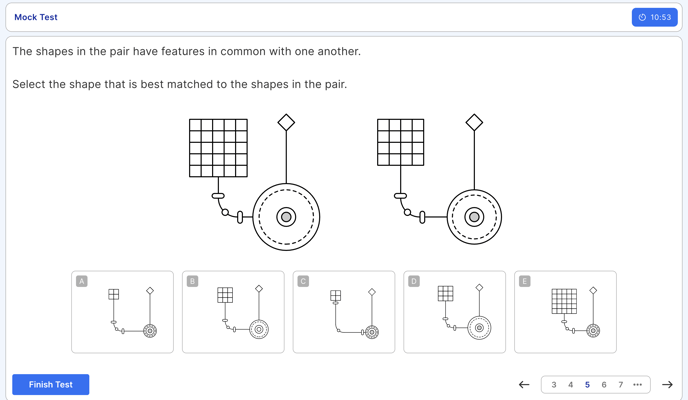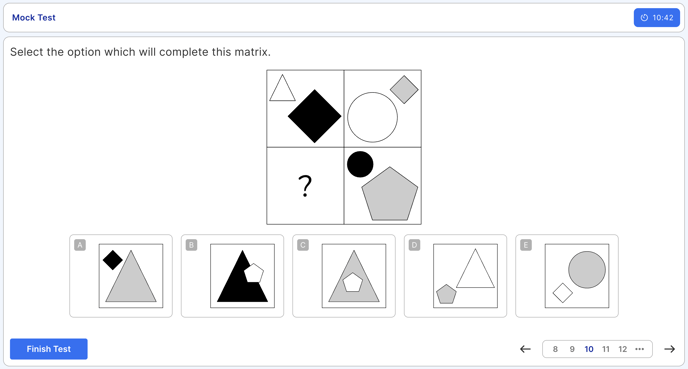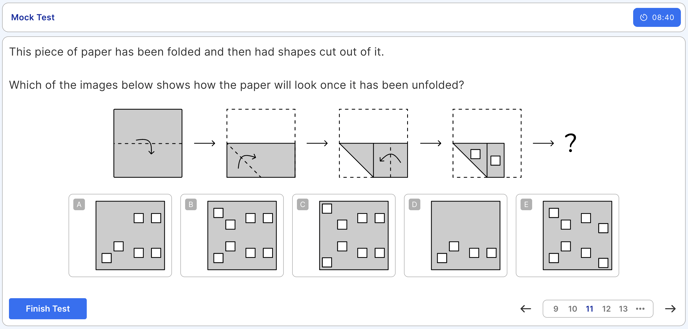The CAT4 test is a Cognitive Abilities Test made by GL Assessment. It helps schools to evaluate a child’s current learning ability and their future academic potential.
While tests in the core subjects allow teachers to assess a child’s knowledge of a particular part of the curriculum, the CAT4 test gives teachers a much more rounded view of a child’s academic capability. This enables them to understand how a child learns and to personalise their learning.
The CAT4 test assesses children in four main areas including verbal, non-verbal, quantitative and spatial reasoning. In the test, a child will complete a variety of tasks which involve using words to express ideas, problem-solving using pictures and diagrams, applying numerical skills and transforming visual images. These types of questions aim to test your child on the foundational skills required for all academic subjects at school, university and beyond.
What is the format of the CAT4 test?
The CAT4 is a multiple-choice, timed assessment, taken under exam conditions. The test itself is 72 minutes and is split into 3 parts. There are 8 subsections tested across these 3 parts, including Figure Classification, Figure Matrices, Verbal, Classification, Verbal Analogies, Number Analogies, Number Series, Figure Analysis and Figure Recognition. At the start of each section there will be introductory information with practice examples to help familiarise children with the style and format of the questions before the test begins.
How are CAT4 results used?
Results from the CAT4 test allow teachers to identify strengths and areas for development. It will help to clarify which learning strategies will be most effective for a particular child, and the level of support they will need to reach their full potential. This test is used by some schools as part of their admissions process, often alongside additional Key Stage 2 assessments or an interview. The test can also be used to stream students into academic sets to ensure that the teaching methods and pace are right for each child.
The Standardised Age Score (SAS) is the most important piece of information derived from the CAT4. The SAS is based on the student’s raw score which is adjusted based on their age at the time of their exam. The standardised age score is mapped onto a normal distribution curve. Achieving a SAS score of 100 places a student as exactly average for their year group. With our Exam Preparation Plus package on Atom Home, your child will receive an SAS score for each mock test they complete. We recommend that students aim for an SAS score of at least 115 in an Atom Learning Mock Test for entry into top UK selective schools.
How Atom can help?
It is vital to perform as well as possible in CAT4 tests as gaining entry into a top set at a top school will give your child a huge advantage in any exams to come all the way up to A-Level.
With our Exam Preparation packages on Atom Home, your child can practice both verbal and non-verbal reasoning skills. With an Exam Preparation Plus subscription, your child can also practice exam technique using our CAT4 mock tests. These tests mirror the real assessment timings, number of questions and skill-based content. Familiarity with CAT4 tests will help your child to perform at their best when sitting the real test either for senior-school entry or for academic streaming at the start of Year 7.
Below are the types of questions your child can expect in each section of the test.
Verbal Reasoning
Verbal Classification
Identify the link between three words which are similar in some way and select the answer that goes best.

Verbal Analogies
Look at a verbal analogy in the form of ‘A=B : C=_’. Work out how the first pair of words is related to each other and then select the word that completes the second pair.

Quantitative Reasoning
Number Analogies
Look at three pairs of numbers, such as ‘4-6, 8-10, 9-_’. Work out how the pairs of numbers are related and then complete the third pair.

Number Series
Identify the rule in the number series and work out what number is needed to complete the sequence.

Non-Verbal Reasoning
Figure Classification
Identify the link or characteristic that the given images have in common and select the image that goes best with them.

Figure Matrices
Work out how the first pair of figures in the matrix is related to each other and then select the one that completes the second pair.

Spatial Ability
Figure Analysis
Look at the given image of a square that is repeatedly folded and then has one or more holes punched through it. Work out what the paper would look like when unfolded.

Figure Recognition
Locate the given target shape within the answer choices.

How to help your child prepare
Top tip!
Remind your child to read the question carefully to understand what they are being asked to do. Use the process of elimination to identify the answers that are definitely wrong to help them find the correct answer!
Verbal & Quantitative Reasoning
- Progress through the Verbal Reasoning Learning Journey on Atom. Quantitative Reasoning questions are included within Verbal Reasoning.
- The key to answering Verbal Reasoning questions is developing a rich vocabulary and reading is the best way to do this. Encourage your child to read a variety of literature, including fiction and non-fiction, using Atom’s Recommended Reading Lists to help them choose a book.
- Your child should write down any new words they come across in a vocabulary log. They should write down the word, along with the definition, a synonym and antonym, and an example of the word being used in a sentence to see the word in context.
- Synonyms and Antonyms are used extensively in Verbal Reasoning questions. Practise these by setting Custom Practices for your child under:
- English - Vocabulary - Meaning of Words - Antonyms and Synonyms.
- Your child should be confident in identifying patterns and relationships between numbers. Practise arithmetic by working through the Maths Learning Journey on Atom to build number fluency.
Non-Verbal Reasoning and Spatial Ability
- Progress through the Non-Verbal Reasoning Learning Journey on Atom. Spatial Ability question types are included within Non-Verbal Reasoning.
- Typically, the same approach can be used for all Non-Verbal Reasoning and Spatial Ability question types. For every question which includes a shape or image, your child should remember to look at the key appearance features: Number, Size, Shape, Total, Angle, Colour, Pattern
A good mnemonic to remember this is - 'Never Say Stop To A Cute Panda’!

- Encourage your child to use pencil and paper to help them visualise the answer more clearly. Eg. your child can make their own nets and cube experiment and see what happens when they fold the sides in different ways.
Top tip!
Use Atom’s CAT4 Mock Tests to familiarise your child with the style and content of the test.
Please note that you must have an Exam Preparation Plus subscription to access Atom's unlimited mock tests.